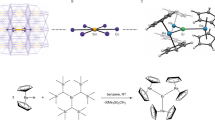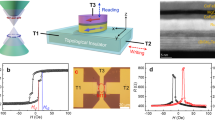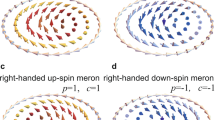Abstract
Recent advances in nanoscience have raised interest in the minimum bit size required for classical information storage. This bit size is determined by the necessity for bistability with suppressed quantum tunnelling and energy barriers that exceed ambient temperatures. In the case of magnetic information storage, much attention has centred on molecular magnets1 with bits consisting of about 100 atoms, magnetic uniaxial anisotropy energy barriers of about 50 K and very slow relaxation at low temperatures. Here, we draw attention to the remarkable magnetic properties of some transition-metal dimers, which have energy barriers approaching 500 K with only two atoms. The spin dynamics of these ultrasmall nanomagnets is strongly affected by a Berry phase, which arises from quasi-degeneracies at the electronic highest occupied molecular orbital energy. In a giant-spin approximation, this Berry phase makes the effective reversal barrier thicker.
This is a preview of subscription content, access via your institution
Access options
Subscribe to this journal
Receive 12 print issues and online access
$259.00 per year
only $21.58 per issue
Buy this article
- Purchase on Springer Link
- Instant access to full article PDF
Prices may be subject to local taxes which are calculated during checkout

Similar content being viewed by others
References
Gatteschi, D., Sessoli, R. & Villain, J. Molecular Nanomagnets (Oxford, New York, 2006).
Sellmyer, D. & Skomski, R. Advanced Magnetic Nanostructures (Springer, New York, 2006).
Billas, I. M. L., Châtelain, A. & de Heer, W. A. Magnetism from the atom to the bulk for iron, cobalt and nickel clusters. Science 265, 1682–1684 (1994).
Skomski, R. Nanomagnetics. J. Phys. Condens. Matter 15, R841–R896 (2003).
Bader, S. D. Colloquium: Opportunities in nanomagnetism. Rev. Mod. Phys. 78, 1–15 (2006).
Gambarella, P. et al. Ferromagnetism in one-dimensional monoatomic metal chains. Nature 416, 301–304 (2002).
Tiago, M. L., Zhou, Y., Alemany, M. M. G., Saad, Y. & Chelikowsky, J. R. Evolution of magnetism in iron from atom to the bulk. Phys. Rev. Lett. 97, 147201 (2006).
Kresse, G. & Furthmuller, J. Efficiency of ab-initio total energy calculations for metals and semiconductors using a plane-wave basis set. Comput. Mater. Sci. 6, 15–50 (1996).
Herzberg, G. Molecular Spectra and Molecular Structure (Van Nostrand Reinhold, New York, 1950).
Jamorski, C., Martinez, A., Castro, M. & Salahub, D. R. Structure of cobalt clusters up to the tetramer: A density functional study. Phys. Rev. B 55, 10905–10921 (1997).
Castro, M., Jamorski, C. & Salahub, D. R. Structure, bonding, and magnetism of small Fen, Con and Nin clusters, n≤5. Chem. Phys. Lett. 271, 133–142 (1997).
Gutsev, G. L. & Bauschlicher, C. W. Jr. Chemical bonding, electron affinity, and ionization energies of the homonuclear 3d metal dimers. J. Phys. Chem. A 107, 4755–4767 (2003).
Valiev, M., Bylaska, E. J. & Weare, J. H. Calculations of the electronic structure of the 3d transition metal dimers with projector augmented plane wave method. J. Chem. Phys. 119, 5955–5964 (2003).
Morse, M. D. Clusters of transition-metal atoms. Chem. Rev. 86, 1049–1109 (1986).
Lombardi, J. R. & Davis, B. Periodic properties of force constants of small transition-metal lanthanide clusters. Chem. Rev. 102, 2431–2460 (2002).
Cehovin, A., Canali, C. M. & MacDonald, A. H. Phys. Rev. B 66, 094430 (2002).
Canali, C. M., Cehovin, A. & MacDonald, A. H. Chern numbers for spin models of transition metal nanomagnets. Phys. Rev. Lett. 91, 046805 (2003).
Lazarovits, B., Simon, P., Zarand, G. & Szunyogh, L. Exotic Kondo effect from magnetic trimers. Phys. Rev. Lett. 95, 077202 (2005).
Pederson, M. R. & Khanna, S. N. Magnetic anisotropy barrier for spin tunneling in Mn12O12 molecules. Phys. Rev. B 60, 9566–9572 (1999).
Garcia-Fernandez, P., Bersuker, I. B. & Boggs, J. E. Lost topological (Berry) phase factor in electronic structure calculations. Example: The ozone molecule. Phys. Rev. Lett. 96, 163005 (2006).
Hirjibehedin, C. F., Lutz, C. P. & Heinrich, A. J. Spin coupling in engineered atomic structures. Science 312, 1021–1024 (2006).
Rizzo, C., Rizzo, A. & Bishop, D. M. The Cotton-Mouton effect in gases: Experiment and theory. Int. Rev. Phys. Chem. 16, 81–111 (1997).
Acknowledgements
We would like to thank D. Bishop, W. de Heer and J. Keto for helpful discussions. This work was supported in part by the Welch Foundation, the National Science Foundation under grant DMR-0606489, the Faculty of Natural Sciences at Kalmar University, the Swedish Research Council under Grant No. 621-2004-4439 and by the Office of Naval Research.
Author information
Authors and Affiliations
Corresponding author
Ethics declarations
Competing interests
The authors declare no competing financial interests.
Supplementary information
Supplementary Information
Supplementary information and equations (PDF 228 kb)
Rights and permissions
About this article
Cite this article
Strandberg, T., Canali, C. & MacDonald, A. Transition-metal dimers and physical limits on magnetic anisotropy. Nature Mater 6, 648–651 (2007). https://doi.org/10.1038/nmat1968
Received:
Accepted:
Published:
Issue Date:
DOI: https://doi.org/10.1038/nmat1968
This article is cited by
-
Solar Driven CO2 Hydrogenation on Ti-Doped Silicon Nanocages
Journal of Cluster Science (2020)
-
Mixed topological semimetals driven by orbital complexity in two-dimensional ferromagnets
Nature Communications (2019)
-
Large magnetic anisotropy in chemically engineered iridium dimer
Communications Physics (2018)
-
Deposition Morphology and Magnetism of Co, Pt Adatoms and Small CoPt Adclusters on Ni(100) Substrate
Journal of Cluster Science (2016)
-
Giant magnetic anisotropy and tunnelling of the magnetization in Li2(Li1−xFex)N
Nature Communications (2014)



